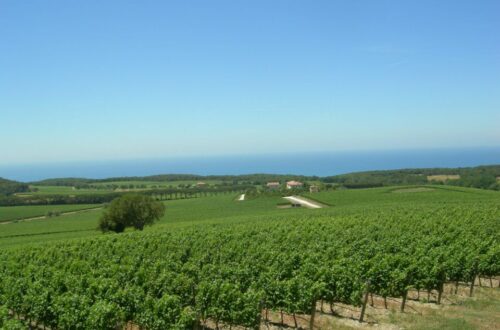Elegant, rustic, and deeply Piedmontese—Dolcetto di Ovada DOC is a wine that tells the story of gentle hills, slow lunches, and centuries-old winemaking tradition.
Table of Contents
What is Dolcetto di Ovada DOC?
Dolcetto di Ovada DOC is a red wine appellation from southern Piedmont, Italy, celebrated for its deep color, juicy dark fruit profile, and almond-kissed finish. Often overshadowed by Nebbiolo in the region, Dolcetto holds its own as the wine of everyday tables—offering both rustic charm and surprising depth.
Its style ranges from fresh and youthful to structured versions capable of short-term aging, making it a versatile choice for wine lovers seeking an authentic taste of Piedmont beyond the usual Barolo and Barbaresco.
History and Origins
The Dolcetto grape has been cultivated in Piedmont for centuries, with historical records suggesting it may have arrived from Liguria during medieval trade routes. Ovada, near the Ligurian border, became a natural home for the variety thanks to its warm climate and well-drained soils.
By the 1970s, the wine’s reputation as a robust, everyday red led to its DOC status. Today, the DOC runs alongside the more prestigious Dolcetto di Ovada Superiore DOCG, which designates longer-aged, higher-quality wines.
Where It’s Made: Geography & Terroir
The Dolcetto di Ovada DOC zone lies in the southern tip of Piedmont’s Alessandria province, near the town of Ovada, close to the Ligurian Apennines.
- Climate: Warm days and cool nights—ideal for ripening while preserving acidity.
- Soils: Calcareous clay with marl, lending structure and minerality.
- Elevation: Vineyards typically range between 200–500 meters, with hillside exposures promoting slow, even ripening.
The Grape
Dolcetto—literally “little sweet one” in Italian—misleads with its name. It produces dry, medium-bodied wines with soft tannins, moderate acidity, and aromas of black cherry, plum, violet, and bitter almond. In Ovada, Dolcetto tends to show richer fruit and more structure than in other Piedmont DOCs like Dolcetto d’Alba.
Winemaking & DOC Regulations
Dolcetto di Ovada DOC Requirements:
- Grape: 100% Dolcetto
- Minimum Alcohol: 11.5%
- Aging: Wines may be released a few months after harvest, with no extended aging required.
- Style: Dry red, medium-bodied, intended for fresh consumption within 2–4 years.
Key Facts at a Glance
| Feature | Details |
| Type | Red, still, dry |
| Region | Piedmont, Alessandria province |
| Grape | 100% Dolcetto |
| DOC Status | Since 1972 |
| Best Drinking Window | 1–4 years after harvest |
| Serving Temp | 16–18°C (60–64°F) |
Tasting Notes
- Color: Deep ruby with violet hues
- Aromas: Black cherry, ripe plum, violets, and subtle almond
- Palate: Smooth tannins, moderate acidity, juicy fruit core with a faint bitter edge on the finish
- Style: Approachable, everyday drinking wine with rustic elegance
Serving & Pairing
Dolcetto di Ovada is a cucina povera champion—its versatility makes it a natural companion for hearty yet simple dishes:
- Perfect With: Agnolotti al plin, mushroom risotto, roasted rabbit, or pizza Margherita.
- Cheese Matches: Taleggio, Toma Piemontese, or young Pecorino.
- Tip: Slightly chill in summer for a refreshing twist.
Where to Buy & Pricing
Dolcetto di Ovada DOC is widely available in Italy and through select importers in the US, UK, and Asia.
- Price Range: €8–€15 ($10–$18 USD) for DOC; €15–€25 ($18–$30 USD) for higher-quality DOCG versions.
- Shop Online: Look for reputable producers like Cascina Gentile, Tenuta Gaggino, or La Casanella.
(Affiliate-ready section for “Buy Dolcetto di Ovada Online” integration)
FAQ on Dolcetto di Ovada DOC
Q: How is Dolcetto di Ovada different from Dolcetto d’Alba?
A: Ovada versions are richer, with more structure and a slightly warmer fruit profile, thanks to the area’s climate and soils.
Q: Can Dolcetto di Ovada age?
A: DOC versions are best young, but DOCG “Superiore” can age 5–8 years.
Q: Is Dolcetto sweet?
A: No—it’s a dry red wine; the name refers to the grape’s low acidity, not sugar content.
Fun Facts & Cultural Notes
- Ovada sits along an ancient salt trade route connecting Liguria to Piedmont.
- In the local dialect, Dolcetto is sometimes called Ormeasco when grown near Liguria.
- Traditionally served in ceramic pitchers at Piedmontese osterie.
CTA for Audience Engagement
“Have you tried Dolcetto di Ovada? Share your tasting notes or favorite producer in the comments—and tag @DrinkItalian on Instagram to be featured!”
Include interactive poll: “Which Dolcetto DOC do you prefer—Ovada, Alba, or Dogliani?”


